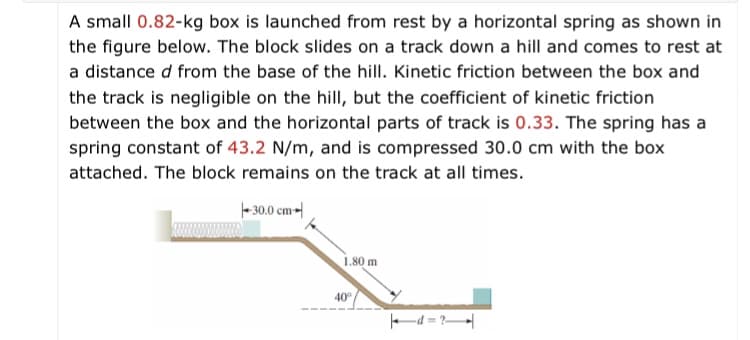A small 0.82-kg box is launched from rest by a horizontal spring as shown in the figure below. The block slides on a track down a hill and comes to rest at a distance d from the base of the hill. Kinetic friction between the box and the track is negligible on the hill, but the coefficient of kinetic friction between the box and the horizontal parts of track is 0.33. The spring has a spring constant of 43.2 N/m, and is compressed 30.0 cm with the box attached. The block remains on the track at all times. -300 cm어 1.80 m 40 -d = ?
A small 0.82-kg box is launched from rest by a horizontal spring as shown in the figure below. The block slides on a track down a hill and comes to rest at a distance d from the base of the hill. Kinetic friction between the box and the track is negligible on the hill, but the coefficient of kinetic friction between the box and the horizontal parts of track is 0.33. The spring has a spring constant of 43.2 N/m, and is compressed 30.0 cm with the box attached. The block remains on the track at all times. -300 cm어 1.80 m 40 -d = ?
Physics for Scientists and Engineers, Technology Update (No access codes included)
9th Edition
ISBN:9781305116399
Author:Raymond A. Serway, John W. Jewett
Publisher:Raymond A. Serway, John W. Jewett
Chapter8: Conservation Of Energy
Section: Chapter Questions
Problem 8.65AP: A block of mass 0.500 kg is pushed against a horizon-tal spring of negligible mass until the spring...
Related questions
Question
1 question just broken up in two pics

Transcribed Image Text:A small 0.82-kg box is launched from rest by a horizontal spring as shown in
the figure below. The block slides on a track down a hill and comes to rest at
a distance d from the base of the hill. Kinetic friction between the box and
the track is negligible on the hill, but the coefficient of kinetic friction
between the box and the horizontal parts of track is 0.33. The spring has a
spring constant of 43.2 N/m, and is compressed 30.0 cm with the box
attached. The block remains on the track at all times.
- 30.0 cm-
1,80 m
40°
d = ?|

Transcribed Image Text:(b) Calculate d.
m
Expert Solution
This question has been solved!
Explore an expertly crafted, step-by-step solution for a thorough understanding of key concepts.
This is a popular solution!
Trending now
This is a popular solution!
Step by step
Solved in 2 steps

Knowledge Booster
Learn more about
Need a deep-dive on the concept behind this application? Look no further. Learn more about this topic, physics and related others by exploring similar questions and additional content below.Recommended textbooks for you

Physics for Scientists and Engineers, Technology …
Physics
ISBN:
9781305116399
Author:
Raymond A. Serway, John W. Jewett
Publisher:
Cengage Learning

Principles of Physics: A Calculus-Based Text
Physics
ISBN:
9781133104261
Author:
Raymond A. Serway, John W. Jewett
Publisher:
Cengage Learning

University Physics Volume 1
Physics
ISBN:
9781938168277
Author:
William Moebs, Samuel J. Ling, Jeff Sanny
Publisher:
OpenStax - Rice University

Physics for Scientists and Engineers, Technology …
Physics
ISBN:
9781305116399
Author:
Raymond A. Serway, John W. Jewett
Publisher:
Cengage Learning

Principles of Physics: A Calculus-Based Text
Physics
ISBN:
9781133104261
Author:
Raymond A. Serway, John W. Jewett
Publisher:
Cengage Learning

University Physics Volume 1
Physics
ISBN:
9781938168277
Author:
William Moebs, Samuel J. Ling, Jeff Sanny
Publisher:
OpenStax - Rice University

College Physics
Physics
ISBN:
9781305952300
Author:
Raymond A. Serway, Chris Vuille
Publisher:
Cengage Learning

Glencoe Physics: Principles and Problems, Student…
Physics
ISBN:
9780078807213
Author:
Paul W. Zitzewitz
Publisher:
Glencoe/McGraw-Hill